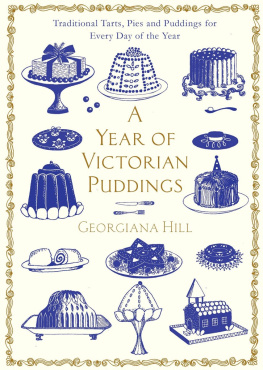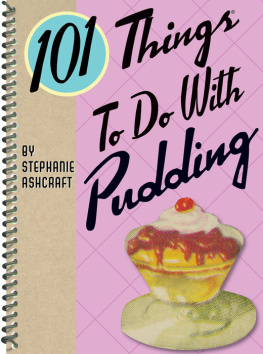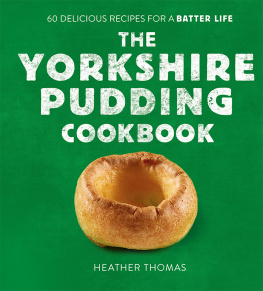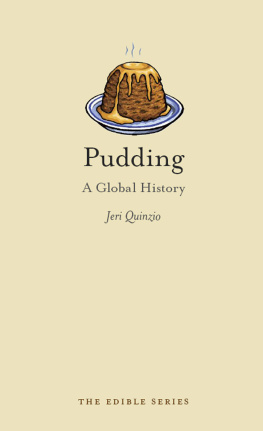CONTENTS
CHAPTER 1
CHAMPION PUDDINGS
CHAPTER 2
SCHOOL-DINNER PUDDINGS
CHAPTER 3
FAMILY FAVOURITES
CHAPTER 4
FORGOTTEN PUDDINGS
CHAPTER 5
PUDDINGS WITH A TWIST
CHAPTER 6
CHOCOHOLICS & NUTCASES
CHAPTER 7
SUMMER PUDDINGS
CHAPTER 8
WINTER PUDDINGS
LIST OF RECIPES
WHAT IS THE PUDDING CLUB?
THE PUDDING CLUB was started in the Cotswold village of Mickleton in 1985 by a small but dedicated group of pudding lovers. They were determined not to let the traditional British puddings they loved and craved become extinct as a result of quick-cook convenience foods and overseas influences!
In the autumn of 1985 this small band of aficionados joined together for an evening of indulgence where the stars included seven delicious puddings childhood favourites like treacle sponge pudding and jam roly poly, which at that time were not widely available. Its hard to believe now but in 1985 they were rarities!
The Pudding Clubs heartfelt mission for over a quarter of a century has been to preserve the Great British Pudding. Indeed, this has been achieved on many restaurant and pub menus, and in farm shops and supermarkets up and down the land. The fame of the Great British Pudding is no longer confined to these shores: The Pudding Club has been on tour overseas and has a following in Japan, North America, Belgium, the Netherlands and Ireland, among other places. International visitors come to our little Cotswold village to experience this slightly eccentric institution, and to be able to say that they have taken part in a Pudding Club meeting and even stayed in a pudding-themed bedroom too. Where else can you sleep surrounded by images of syrup sponge or spotted dick and custard?
Guests at Pudding Club meetings enjoy a whole evenings entertainment, from a jovial introduction by the Pudding Master through the Parade of Seven Puddings, with all its noise and ceremony, to the vote for best pudding of the night! Pudding Club meetings have been likened to many things but a couple of comments stay in the memory: Like making love in a thunderstorm, a medieval banquet with custard, and it has even been described as the eighth wonder of the world. Visitors to a Pudding Club meeting will understand that the evening is about indulgence, fun and being a bit naughty to boot! You too can join in the fun and attend a meeting ().
Sheila Vincent is the queen of puds in Mickleton, and shes now world-famous too after producing amazing puddings and seven gallons of custard every Friday night for so many years! As for the three of us, were passionate about puddings and proud to be passing on our treasured recipes to you we hope you will eat, drink and be merry!
JILL, PETER & SIMON
THE GREAT BRITISH PUDDING
Steamed or baked; layered or rolled; scattered with crumble; served hot with custard or cold with cream the British pudding comes in countless shapes, sizes and styles. Our traditional puddings have become famed the world over.
The history of the British pudding is long and varied. Many recipes can be traced back through the centuries, immortalised in old cookbooks or passed down from one generation to the next. For many of us, a particular pudding can evoke childhood memories or nostalgia for the good-old days. For others, they promise the warmth and comfort of home, of meals shared with loved ones, or lazy Sunday afternoons.
The British pud is currently enjoying a much-deserved revival in popularity, with celebrity chefs and restaurants featuring traditional puddings on their menus. But whilst some recipes have been constantly revived and reinvented, such as our celebratory trifles and famous lemon meringue pie, others have been almost forgotten, such as the Kentish well pudding or apple dappy. This book celebrates them all, combining classics, new twists and lesser-known recipes rescued from the past. So whether youre feeding your family or entertaining guests, splashing out or cooking on a budget, you will find perfect puddings for every occasion.
OUR RECIPES
This book is a collection of recipes that have been served at Pudding Club meetings over the years. From 15th-century recipes, to our contemporary Millennium pudding, they represent a timeline of pudding history. Since our puds are normally much larger (as we serve up to 70 people), each recipe has been adapted for cooking at home and thoroughly updated to use ingredients available today, but still retaining wonderful traditional elements. Most notable is suet, which these days has largely disappeared from British kitchens (aside from its use in dumplings), but many of our puddings would be unrecognisable without it. Vegetable suet is available in any supermarket, whilst fresh beef suet can be bought from most butchers and is very economical. We also encourage you to seek out some of the lesser-used seasonal British fruits, such as damsons, gooseberries, rhubarb and quince it was for these traditional fruits that many puddings were devised, and we think they deserve to be enjoyed as originally intended.
COOKING TIPS
Because many pudding recipes are prepared, assembled and cooked in similar ways, a number of instructions crop up again and again in the recipes throughout this book. This section outlines some of the most commonly used equipment and techniques.
PUDDING BASINS
A book on British puddings wouldnt be complete without the archetypal steamed variety, with its iconic basin shape. These are among the oldest domestic British puddings until the 19th century, very few kitchens had ovens, so food had to be boiled or steamed. There are two types of steamed pud: the sponge-based pudding, made like a batter and poured into a greased basin, and those that require suet pastry, which is used to line the basin, producing a crumbly outer crust and dense interior.
In this book we generally use a 1.1 litre (2-pint) basin. Very occasionally we specify a 1.5-litre (2-pint), 1.7-litre (3-pint) or 2.3-litre (4-pint) basin. Some of our recipes require individual 200ml (7fl oz) basins. If you dont have the necessary size, feel free to improvise by dividing your ingredients between smaller basins or by multiplying the ingredients to fit a larger one, but never fill the basin more than two-thirds full. (If you dont have a pudding basin, you can use a regular bowl, but do make sure its heatproof and heavy-duty as it will need to withstand several hours submerged in a hot pan of water.) Remember that adjusting the basin size will also affect the cooking time, so check the pudding to determine whether its properly cooked.
LINING A BASIN WITH PASTRY
Divide the suet pastry into two thirds and one third and set the smaller piece aside. Grease the pudding basin with butter and dust your work surface with flour. Roll out the larger piece of dough into a rough circle and position it inside the greased basin, pressing it snugly against the edges. Add the other ingredients to the pudding as directed in the recipe, then roll out the smaller piece of dough, wet the edges, and place on top, pushing down gently at the edges so that the two pieces of pastry stick to each other.
An alternative lining method is to roll out the whole piece of dough into a circle, then cut away a quarter to save for the lid. Place the larger piece inside the basin, bring the two cut edges together and press them to join. Once youve filled the pudding, re-roll the reserved pastry into a circle that will fit on top and adhere by wetting the edges with water and pushing down, as described above.
Next page










